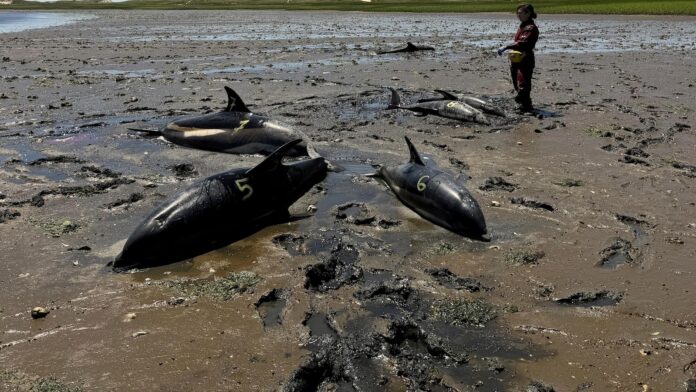Rescuers who freed more than 100 dolphins from the Cape Cod coastline say they have confirmed that the mass stranding which began on June 28, was the largest dolphin operation in U.S. history.
There have been two previous recorded incidents in Hawaii and the Florida Keys involving dolphin species swimming in shallow water. However, the incident on Cape Cod is the highest number of dolphin strandings in one incident, according to the International Fund for Animal Welfare, which helped lead the rescue effort.
A final analysis of the data and aerial photographs this week showed a total of 146 dolphins were involved in the stranding, said Stacey Hedman, IFAW’s communications director.
The group estimated that 102 dolphins survived the multi-day event. There were 37 natural deaths and seven dolphins had to be euthanized.
Relief efforts have continued on a smaller scale, including the rescue, translocation and release of nine of the same Atlantic white-sided dolphins on July 2.
That day, 11 dolphins were found stranded near Powers Landing in Wellfleet, Massachusetts. Two were euthanized and nine were transported in a specially built mobile dolphin rescue clinic vehicle where veterinarians and biologists can administer fluids and other treatments en route to a deeper-water location, Hedman said.
In this case, she said, the dolphins were released near Herring Cove Beach in Provincetown. Satellite tags tracked several of the animals safely out to sea.
There is no clear reason why the dolphins stranded.
Rescuers faced many challenges as they tried to guide the dolphins back to open water, including dealing with difficult mud conditions and the dolphins being scattered across a large area.
In some rescues, workers set out on foot to herd the animals to deeper water, then used small boats equipped with underwater pingers, which make noises to attract the animals.
Several dolphins died on The Gut — or Great Island — in Wellfleet, on the Herring RiverThe Gut is a site of frequent beachings, which experts say is partly due to its hook-shaped shape and extreme tidal fluctuations.
“This stranding response was a huge effort by our staff, volunteers and partners over several days,” Hedman said, adding that the group considers the response a success, with a survival rate of about 70 percent.
The organization has also received reports from whale watchers who have seen a number of dolphins – identified by temporary tags – now swimming among other pods of hundreds of other dolphins that were not part of the stranding.
Those assisting with the overall rescue included more than 25 IFAW staff and 100 trained volunteers. The group also received support from Whale and Dolphin Conservation, the Center for Coastal Studies, AmeriCorps of Cape Cod and the New England Aquarium.



